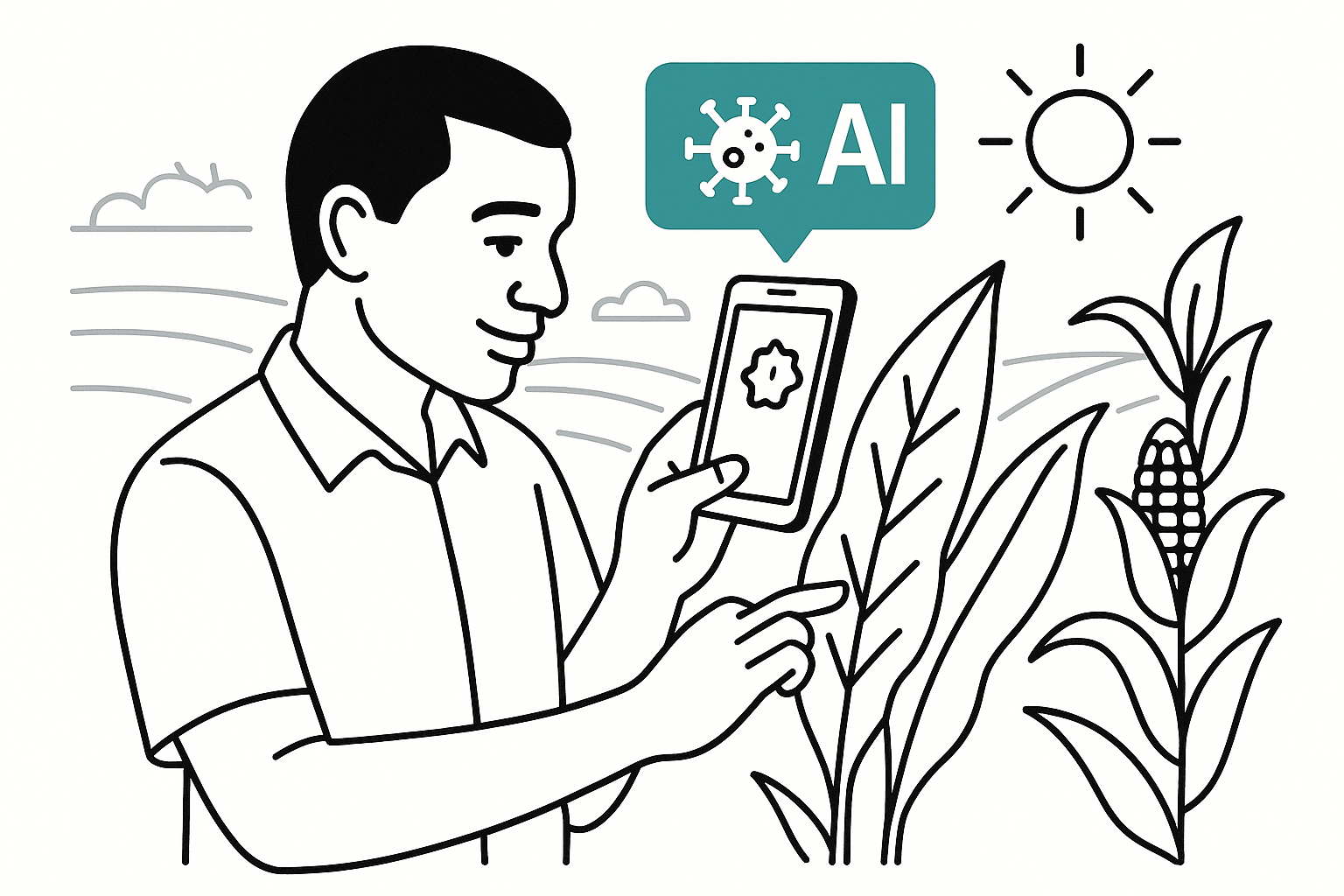In the vast expanses of Kenya’s Rift Valley and coastal plains, a quiet transformation is underway. Farmers, once reliant on traditional methods passed down through generations, are now turning to smartphones to diagnose crop ailments and optimise yields.
This shift is epitomised by the Kenya Agriculture Intelligence Pilot (KAIP), a government-backed initiative launched on February 12, 2025, in collaboration with Oracle. KAIP integrates machine learning, local agricultural data, and cloud connectivity to address persistent challenges, including crop diseases, climate-induced stress, and productivity shortfalls.
Agriculture remains the backbone of Kenya’s economy, employing over 40% of the population and contributing approximately 33% to the gross domestic product (GDP). Yet, the sector faces formidable hurdles: yields are among the lowest in the world, with smallholder farmers—who account for 75% of agricultural output—struggling against pests, droughts, and inadequate inputs.
Globally, Africa produces only about 10% of the world’s agricultural output despite having 60% of the planet’s arable land. In Kenya, annual crop losses reach up to 40% due to pests and diseases, exacerbating food insecurity for millions of people.
KAIP represents more than a technological novelty; it’s a strategic response to these issues, aiming to leverage artificial intelligence (AI) for scalable solutions. By combining satellite imagery, drone surveillance, and AI-driven apps, the pilot seeks to empower farmers with real-time insights.
This initiative aligns with broader continental efforts, where AI is projected to add $15.7 trillion to the global economy by 2030, with agriculture in Africa poised to benefit significantly through improved efficiency and resilience.
For Kenya, where 60% of the workforce depends on farming, KAIP is a critical test of AI’s potential to enhance food security and economic stability.
The pilot’s launch marked a pivotal moment, with officials emphasising its role in modernising agriculture. As Principal Secretary Kipronoh Ronoh noted during the event, KAIP will enable data-driven decision-making, replacing outdated manual systems with automated intelligence.
This article examines the mechanics of KAIP, its integration with existing tools, its real-world impacts, challenges, and Kenya’s broader AI strategy, while drawing global comparisons to highlight its innovative edge.
Why Kenya Chose Agriculture as Its AI Flagship
Kenya’s selection of agriculture as the cornerstone of its AI ambitions is rooted in economic necessity and strategic foresight. As a leading exporter of tea, coffee, and horticultural products—generating over $3 billion annually—the country nonetheless grapples with domestic food insecurity. Approximately 3.4 million Kenyans face acute food shortages, exacerbated by climate variability and supply chain inefficiencies.
Crop losses are a significant concern: pests and diseases claim 30-40% of annual harvests, while drought affects approximately 80% of the land. Traditional extension services, where field officers provide advice, are overstretched, with one officer often serving 1,500 households or more in rural counties. This gap leaves smallholders, who farm on plots averaging 1.5 hectares, vulnerable to misinformation and delayed interventions.
AI addresses these bottlenecks with unparalleled scalability. A single AI model can analyse millions of images in seconds, delivering personalised advice in local languages like Swahili, Kikuyu, or Luo. Satellite data from partners like the Kenya Space Agency enables rapid mapping of soil moisture and vegetation health, far surpassing human surveys. For instance, AI-powered platforms have demonstrated yield increases of up to 30% in pilot areas by optimising inputs and predicting outbreaks.
By prioritising agriculture, Kenya positions AI as a practical tool for survival rather than a luxury. This approach echoes the nation’s history of technological leapfrogging, such as the widespread adoption of mobile money via M-Pesa, which revolutionised financial inclusion. In agriculture, AI promises similar disruption, fostering a “digital green revolution” tailored to African contexts.
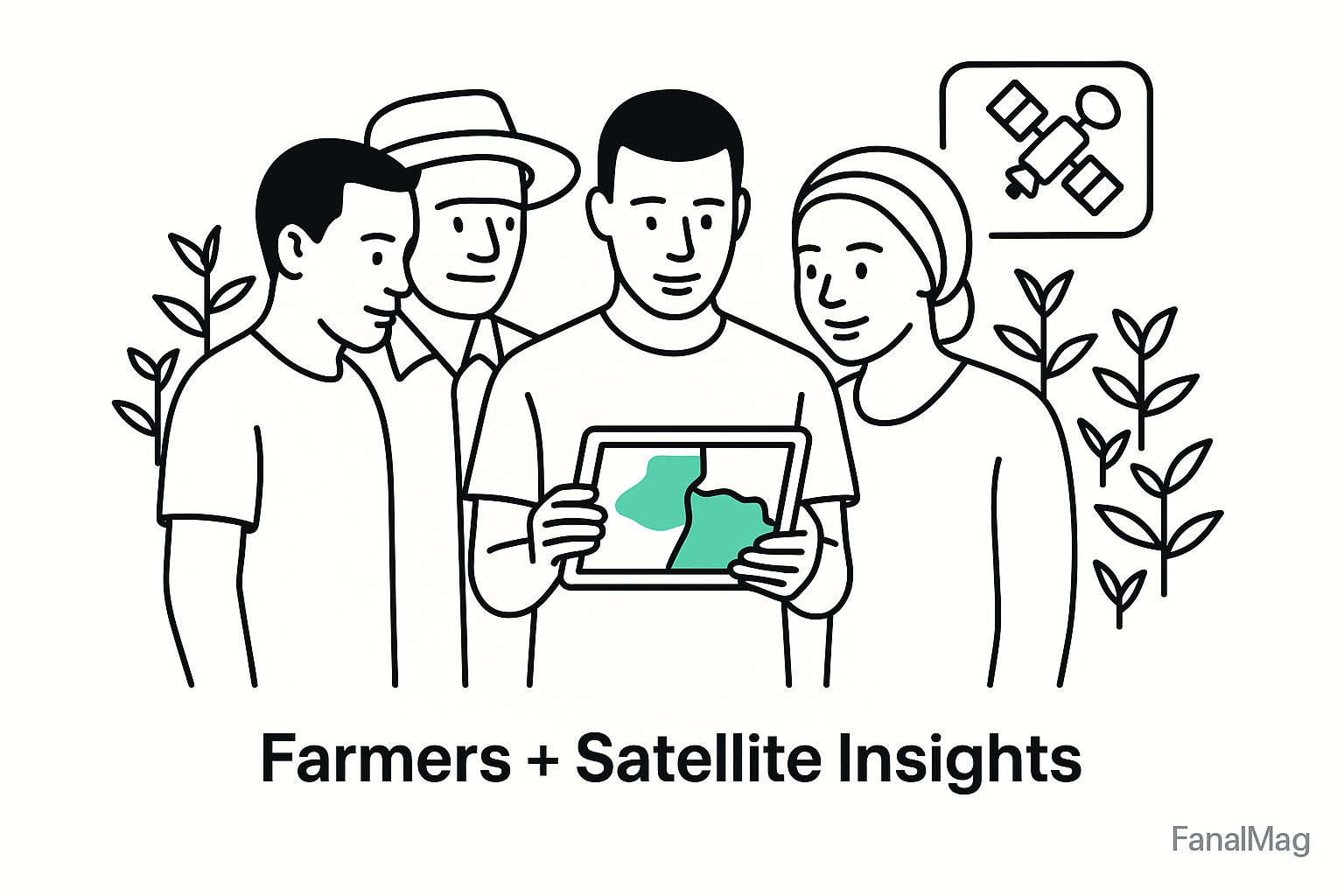
How the Pilot Works in Practice
KAIP operates through a multi-layered technological framework, blending on-ground tools with advanced analytics.
Smartphone AI Apps
At the core are mobile applications that empower farmers to diagnose issues instantly. Farmers capture images of affected leaves or stems using their phones.
Convolutional neural networks (CNNs), trained on datasets specific to Kenyan crops, identify threats like maise streak virus, coffee rust, or tomato blight. The system then provides actionable recommendations, such as dosage for treatments or preventive measures.
Prominent among these is the PlantVillage app, which utilises AI to detect pests and diseases in crops such as cassava and maise. Developed by a non-profit, it has been tested in western Kenya, where farmers report up to 30% reductions in losses through early detection.
Similarly, the Tumaini app, focused on bananas and beans, analyses plant parts for symptoms, supporting low-quality images to accommodate basic smartphones.
KAIP integrates these with government data, ensuring advice is localised. Feedback from users refines the models, creating a continuous improvement loop.
Satellite and Drone Integration
Overhead surveillance enhances ground-level data. Startups like Amini offer satellite-based monitoring, utilising AI to provide insights into crop health and environmental risks. Farmers receive SMS alerts for anomalies, such as water stress or pest hotspots.
Drones, partnered with entities like Hello Tractor, scan fields for precise mapping. In collaboration with Atlas AI, predictive models forecast tractor demand, optimising mechanisation in regions like Kenya’s central highlands. This layer has proven effective in reducing water waste by 25% through targeted irrigation guidance.
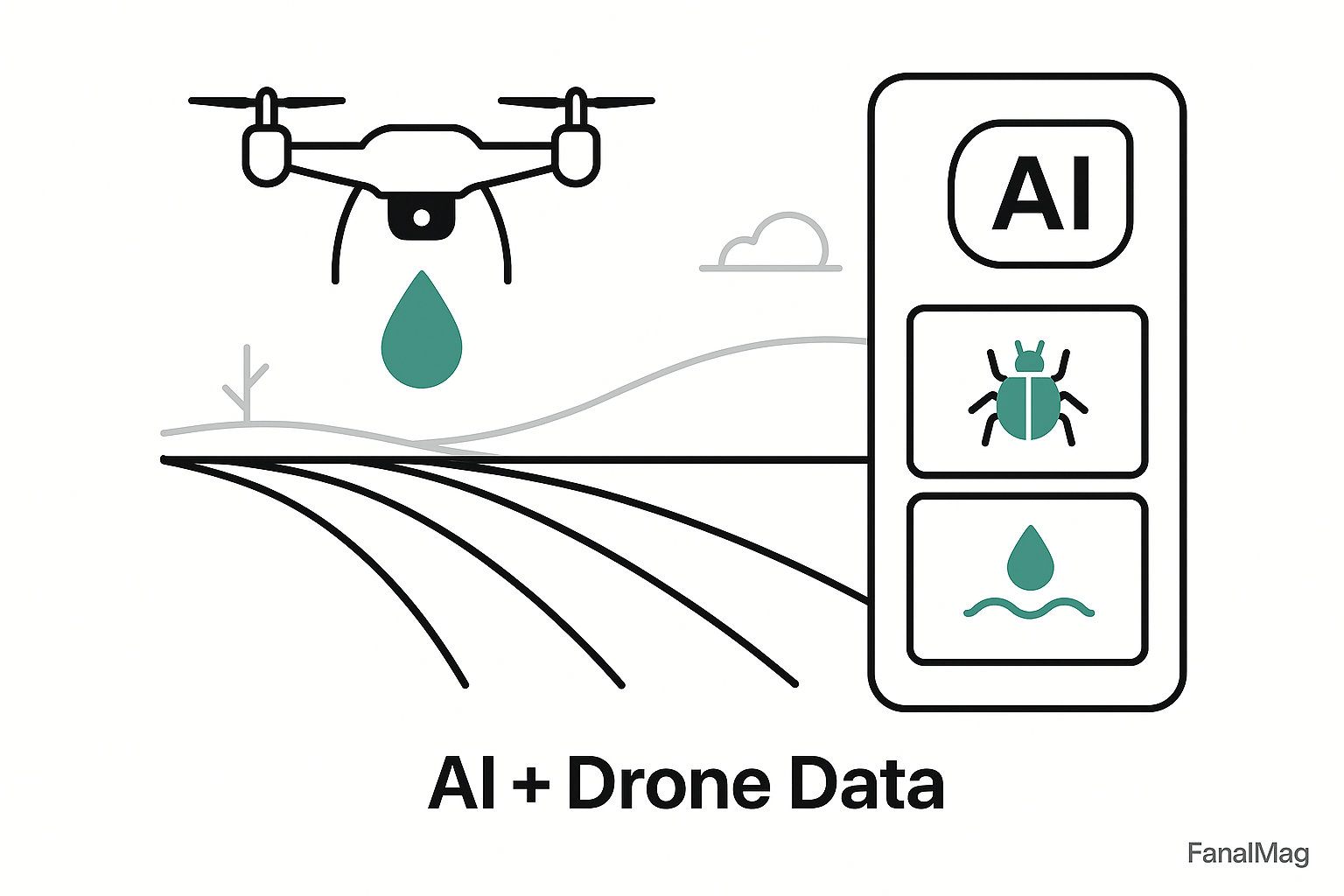
Localised AI Models
Unlike generic Western tools, KAIP’s models are trained on Kenyan-specific data, incorporating regional soil types, climate patterns, and crop varieties. Partnerships with the International Livestock Research Institute (ILRI) use AI for personalised weather and crop advisories. The pilot currently covers 800-1,000 farmers in Nakuru, Kisumu, and Meru counties, with plans to expand nationally by 2027.
Farmers on the Ground: Real Stories from the Pilot
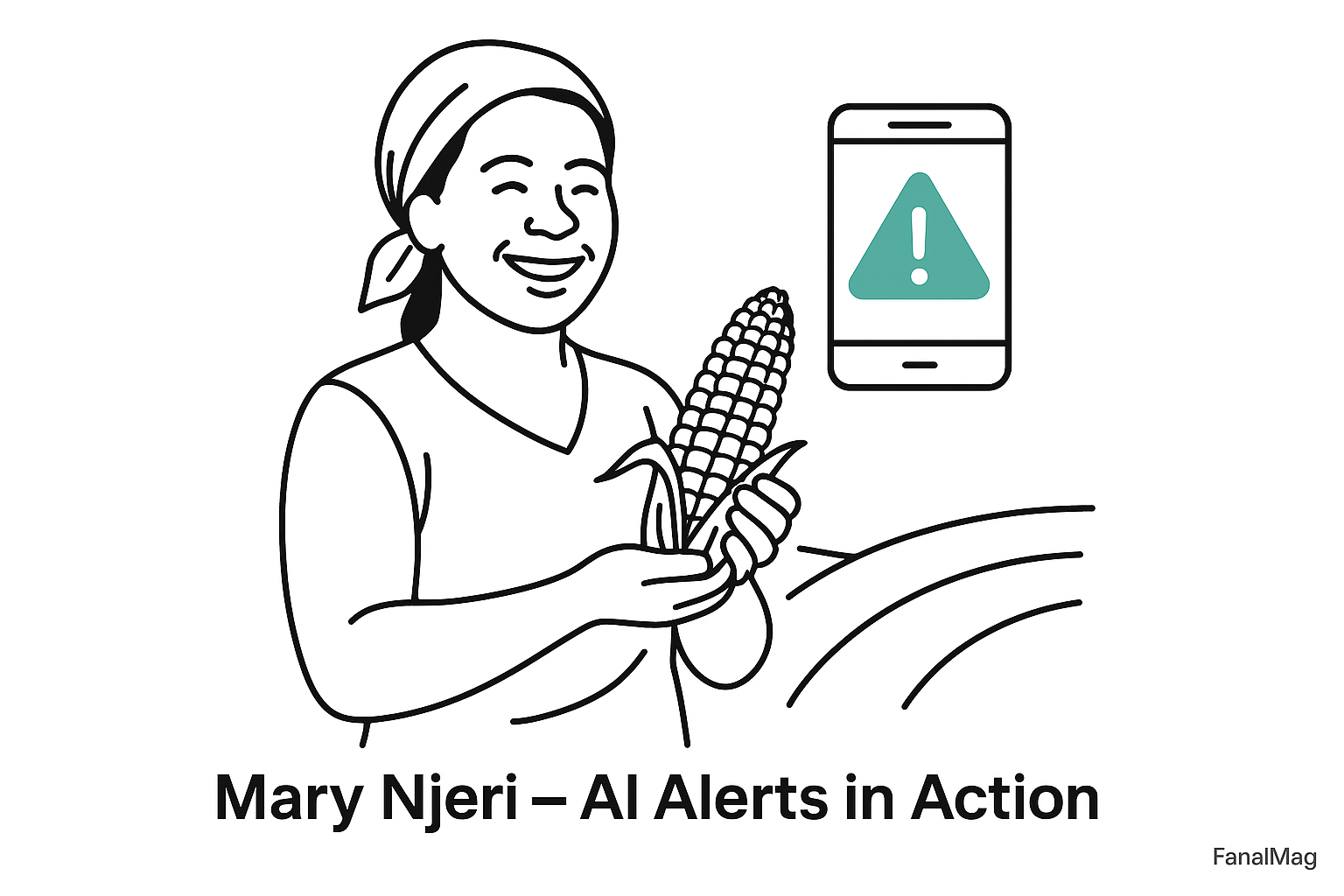
The accurate measure of KAIP’s success lies in the experiences of its farmers. In Nakuru, maise farmer Mary Njeri credits the app for averting an armyworm outbreak. “Last year, I lost half my crop,” she recalls. “With the app, I got a warning two weeks early and saved 80% by spraying promptly.”
In Kisumu, tomato grower Ochieng Otieno praises the multilingual interface: “It spoke Swahili and showed pictures like a doctor’s chart, helping me compare my leaves directly.” His yields improved by 25% after following AI-recommended treatments for blight.
Youth engagement is notable. Digital natives under 30 are combining AI with social media platforms, such as TikTok, to create hybrid knowledge systems. Esther Kimani, a Kenyan innovator, developed an AI device for pest detection, winning accolades for reducing losses by up to 30%. These stories highlight grassroots adoption, with farmers demanding features like integrated market price alerts.
Virtual Agronomist, another tool, has reached over 30,000 farmers, providing tailored advice on maise, tea, coffee, and rice. One user in Ethiopia, similar to Kenyan pilots, reported a 20% increase in yield.
Benefits Beyond Yield
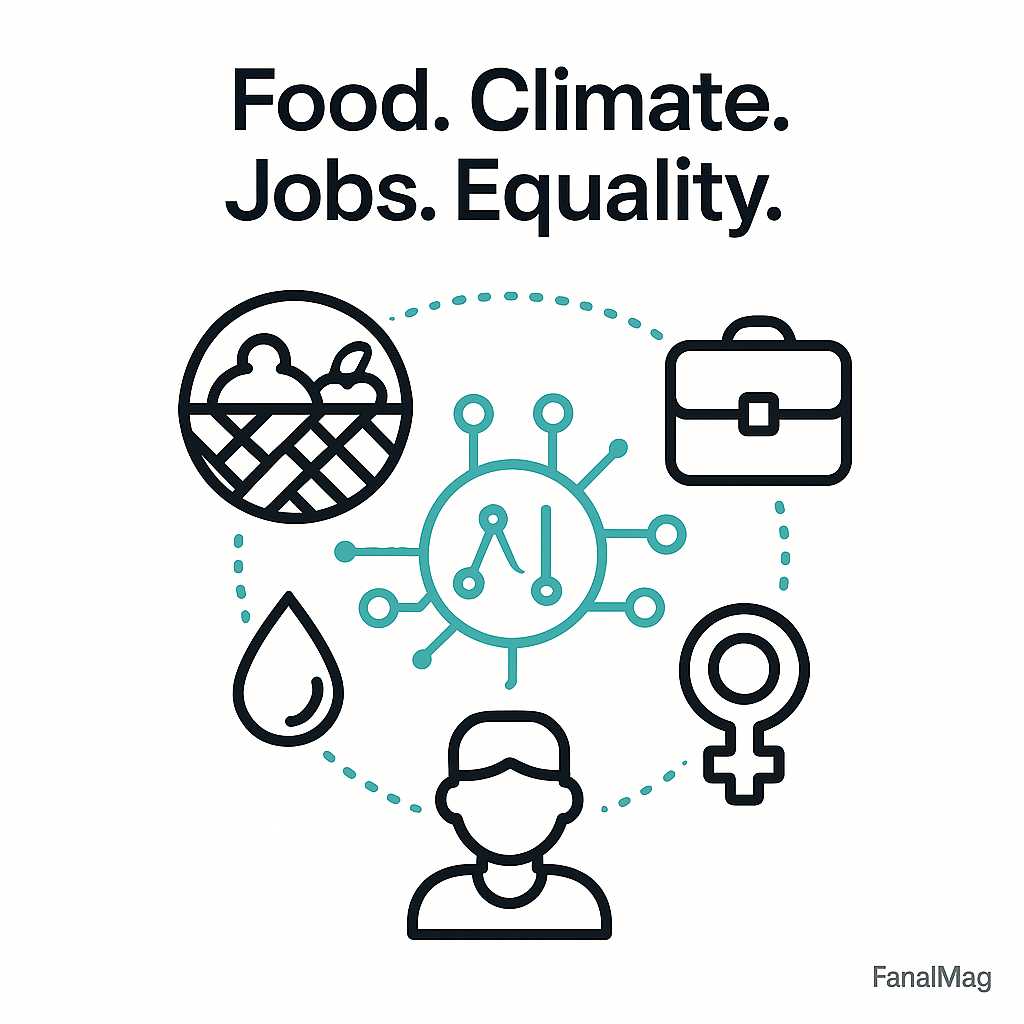
KAIP’s impacts extend far beyond immediate harvests, influencing broader socio-economic and environmental dimensions through AI integration.
Food Security
Scaled up, the pilot could yield 15-20% gains, potentially feeding 5 million more people annually. AI’s predictive analytics mitigate losses, stabilising supply chains. In Kenya, where agriculture contributes 33% to GDP and employs over 40% of the population, AI-driven tools like precision farming apps have demonstrated significant yield enhancements.
For instance, AI applications in crop monitoring and yield prediction have improved output by up to 25% by optimising input use and reducing waste, as seen in initiatives across Sub-Saharan Africa. Specifically, platforms such as Farmonaut enable Kenyan farmers to detect pests and diseases early, boosting crop yields for staples like maize and coffee.
Harvest Group’s endorsement of Kenya’s AI approach underscores how these technologies support food security by enhancing efficiency and addressing chronic issues, such as post-harvest losses, which account for 30-40% of produce annually.
Further, AI interventions have reduced pesticide usage by 15% while increasing yields by a similar margin, balancing productivity with sustainability. In pilots similar to KAIP, such as AgWise, crop productivity has risen by up to 30%, closing yield gaps in sub-Saharan Africa and optimising fertiliser application to minimise environmental impact.
These gains are crucial in a context where Kenya imports substantial food volumes, despite its export prowess, with AI enabling real-time monitoring to prevent outbreaks and ensure a consistent supply. By 2030, such technologies could contribute to feeding an additional 200 million people across Africa through improved resource efficiency and data-driven decision-making.
Climate Adaptation
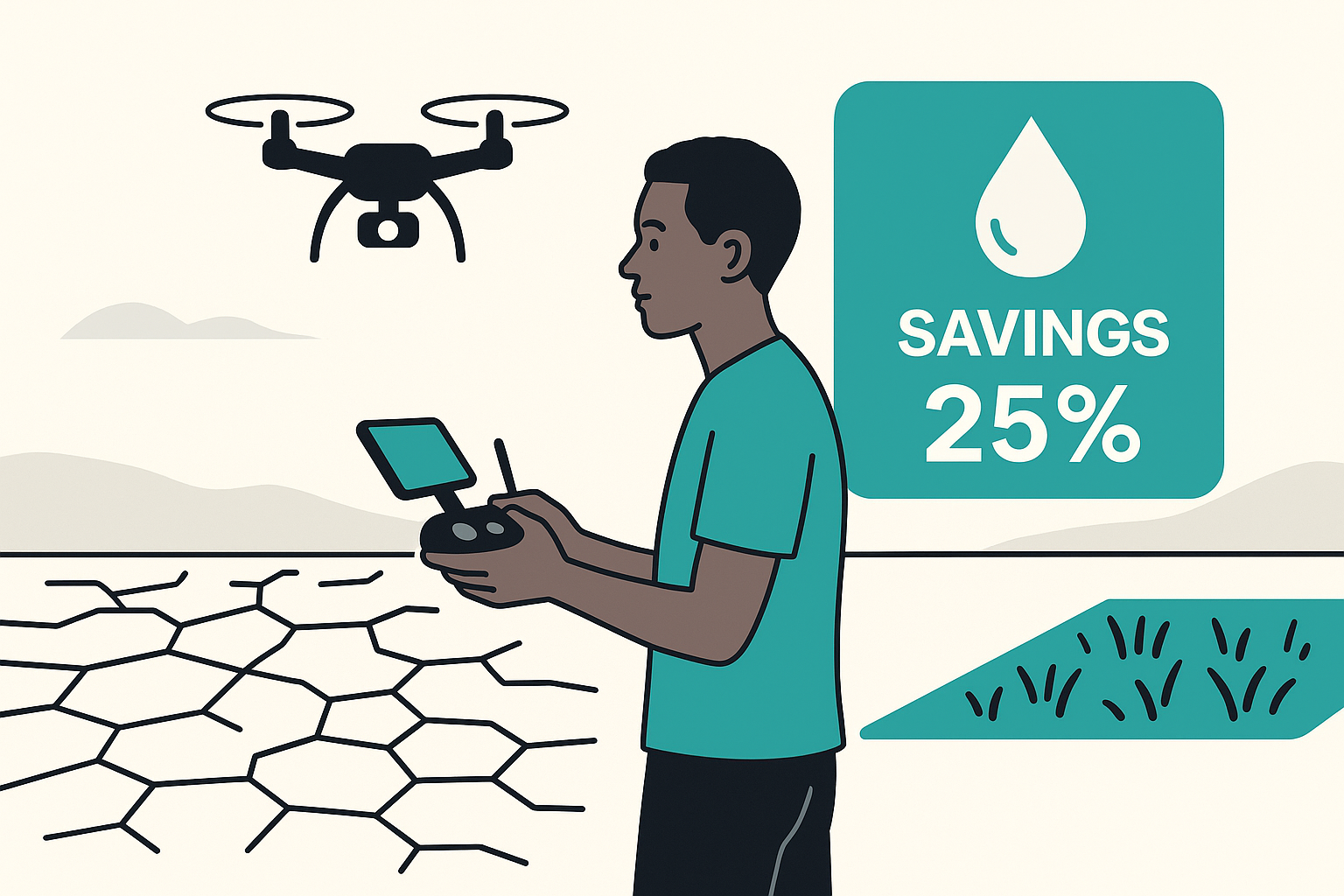
Real-time guidance reduces water usage by 25%, a crucial benefit in drought-prone areas. Satellite overlays facilitate informed planting decisions and help adapt to erratic rainfall patterns. In Kenya, where droughts affect approximately 80% of the land and have led to recurrent food crises, AI tools such as machine learning-based prediction models can enhance resilience.
For example, AI-driven drought forecasting in Kenya enhances early warning systems, enabling farmers to adjust their irrigation and crop choices proactively. Initiatives such as solar-powered “Smart Tap” systems in Isiolo County address water scarcity by optimising distribution during severe droughts, reducing waste and supporting crop survival.
AI also aids in developing drought-resistant crops through gene identification and breeding simulations, conserving water and mitigating climate stress.
In East Africa, big data and AI provide real-time information for sustainable water management, fostering climate-smart agriculture. Studies show that the integration of AI in anticipatory response planning has reduced agricultural losses, as evidenced by the Kenya National Drought Management Authority.
Overall, these adaptations could save up to 30% in water resources while increasing resilience to extreme weather, aligning with Kenya’s goal of climate-proofing its agricultural sector by 2030.
Youth Employment
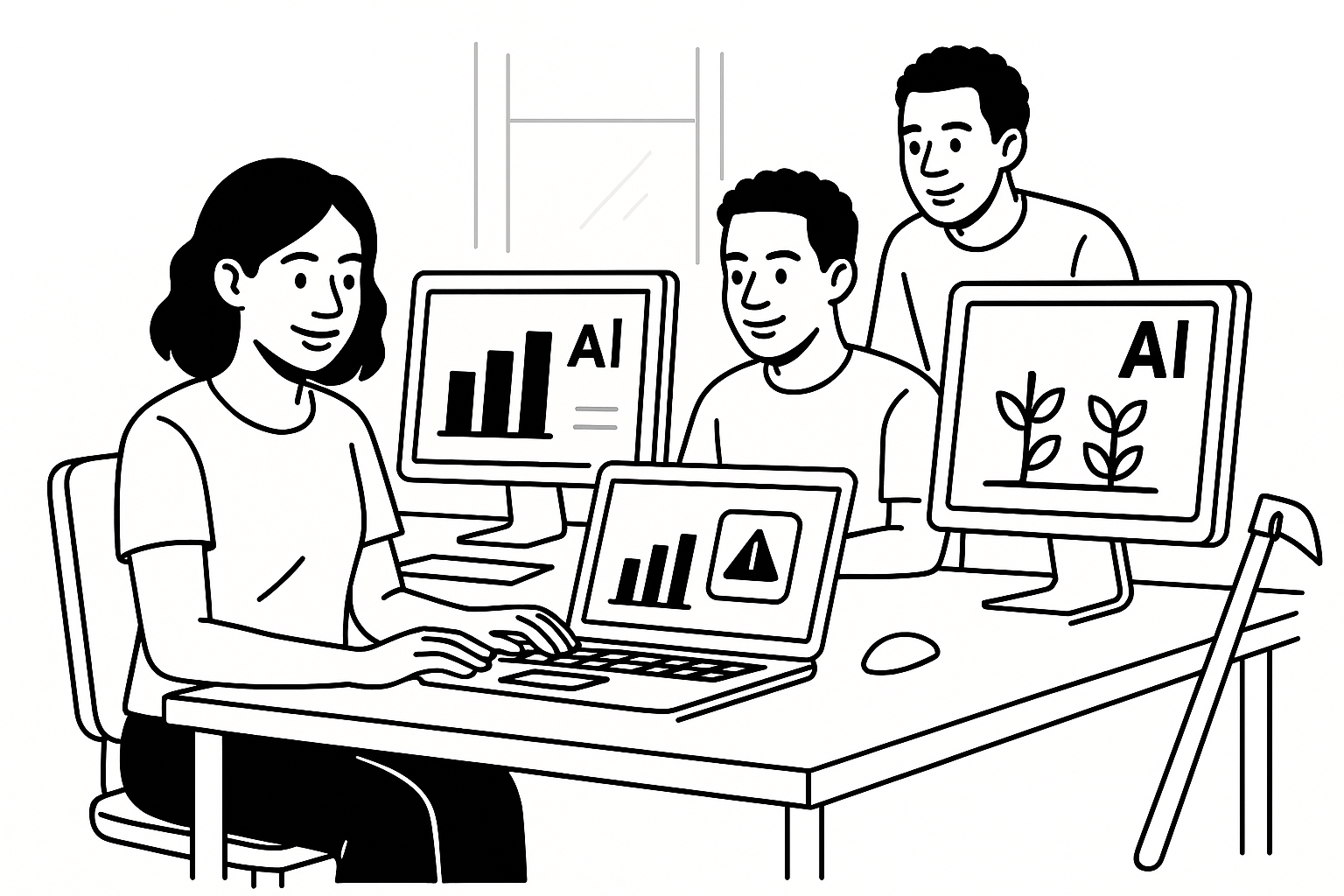
Agri-tech startups employ drone pilots, data analysts, and trainers, thereby diversifying job opportunities in rural areas. Over 5 million farmers benefit from AI weather forecasts via TomorrowNow. In Kenya, the agri-tech sector is booming, with startups creating thousands of jobs for youth in digital farm management, drone operations, and AI data analysis.
For instance, companies like Apollo Agriculture, Synnefa, and SunCulture are leading the charge, employing young professionals in roles that leverage AI for credit assessment, precision farming, and solar irrigation. The AI market is projected to contribute US$2.4 billion to Kenya’s GDP by 2030, generating over 300,000 new jobs, with a significant portion in agri-tech.
Competitions like AYuTe NextGen 2025 highlight youth-led innovations, crowning entrepreneurs who develop AI tools for agriculture, fostering economic growth and employment. Grassroots AI communities in Kenya are shaping the landscape, providing training and opportunities that address the 35% youth unemployment rate.
With 182 agri-tech startups in Kenya as of 2025, including 49 funded ones, the sector is disrupting traditional farming while creating tech-savvy roles for the under-30 demographic, which constitutes 75% of the population. This shift not only diversifies rural economies but also positions youth as drivers of sustainable agricultural transformation.
Gender Inclusion
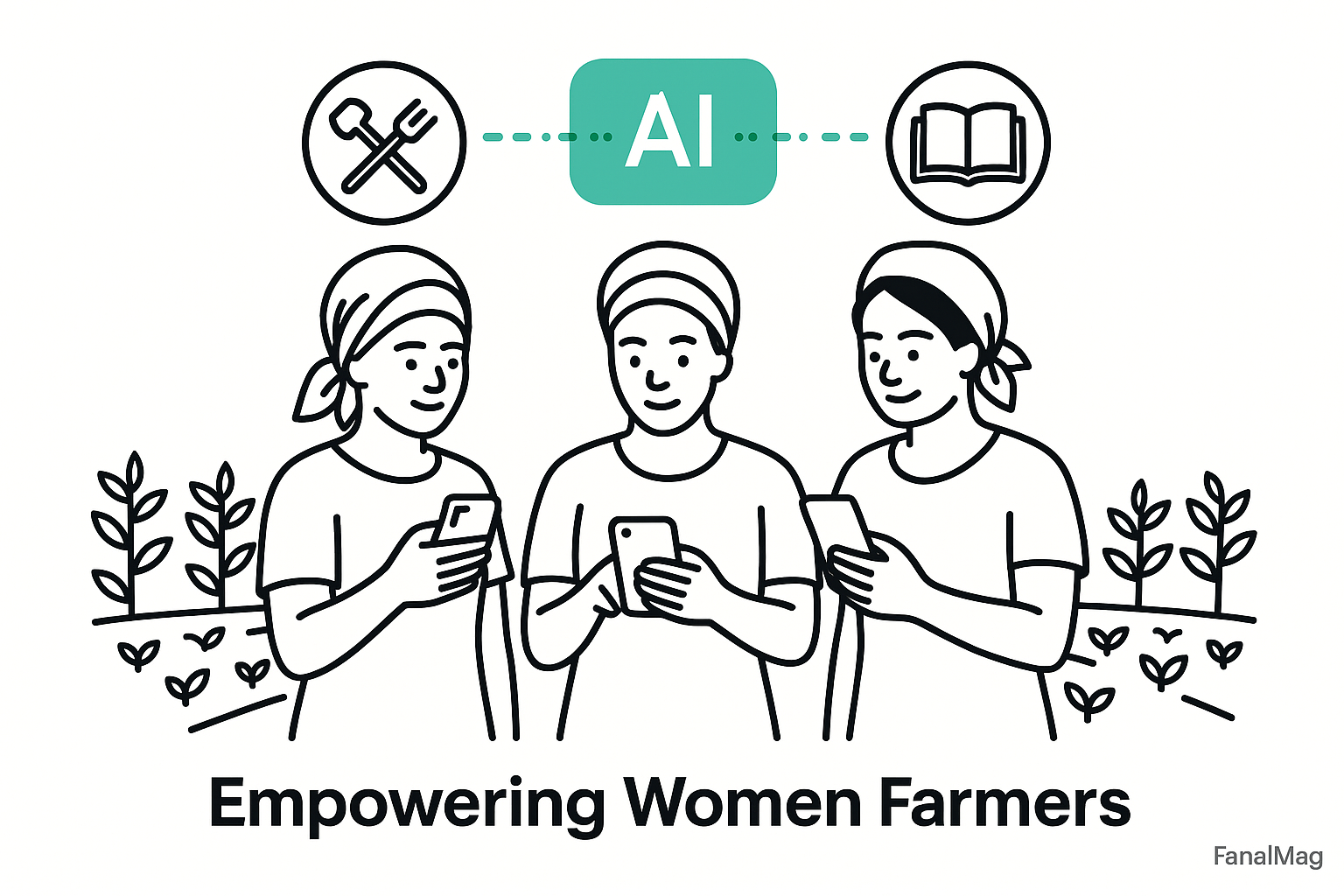
Women, comprising 70% of smallholders, access knowledge independently, bypassing male-dominated extension services. AI-powered tools, such as mobile apps, offer tailored advice on farming practices, weather, and market conditions, empowering women to enhance their productivity.
In Kenya, where women produce the majority of food but own less than 20% of land, AI chatbots deliver real-time agricultural guidance, reducing gender inequities in information access. Projects focused on gender mainstreaming in AI ensure tools are designed with women’s needs in mind, such as voice-activated interfaces in local languages.
Digital microinsurance and training programs target women farmers, increasing input adoption and financial inclusion. Capacity-building initiatives, including AI literacy workshops, enable women to coordinate buying power and leverage precision agriculture.
Gender-inclusive extension approaches have closed knowledge gaps, resulting in a 15-20% increase in product uptake among women smallholders. By aligning AI with socio-economic realities, these efforts reduce inequalities, promote sustainable development, and empower women as key players in Kenya’s food systems.
Challenges and Criticisms
Despite the promise, hurdles persist.
- Connectivity gaps persist in rural areas, with internet penetration rates below 40% in some regions. Offline modes are essential.
- Costs for smartphones and subscriptions exclude the poorest, necessitating the provision of subsidies.
- Model biases arise when training data favours central Kenya, underperforming in arid zones such as Turkana.
- Dependency risks “algorithm worship,” eroding indigenous knowledge. Experts urge AI as a complement, not a replacement.
- Data shortages and ethical concerns, such as privacy concerns in farmer profiling, demand robust policies.
Kenya’s AI Strategy 2025–2030
Launched on March 27, 2025, by the Ministry of Information, Communications, and the Digital Economy, the strategy outlines four pillars: agriculture, healthcare, education, and public services. With a KES 6.2 billion ($48 million) budget over five years, it aims to position Kenya as Africa’s leader in AI.
Agriculture is the flagship, integrating KAIP into national systems. Partners include the UN FAO, IBM Research Africa, and local organisations such as Twiga Foods. The strategy emphasises ethical AI, data sovereignty, and skills development, aiming to reach 1 million AI-literate citizens by 2030.
Compared to peers, Kenya outpaces Ethiopia and Nigeria in policy agility, focusing on practical applications.
Metrics for Measuring the Success of the KAIP Initiative
The Kenya Agriculture Intelligence Pilot (KAIP), launched in February 2025 as part of the Ministry of Agriculture and Livestock Development’s digital transformation efforts, focuses on crop monitoring, yield estimation, early warnings for pests and diseases, real-time data collection, and policy feedback through a national dashboard.
While official documents do not outline an exhaustive list of key performance indicators (KPIs), success is evaluated based on operational goals and broader benchmarks for the AI strategy. These include:
- Adoption and Reach: Number of farmers integrated into the system, with a benchmark of expanding from the initial pilot to 50,000 users by 2026 and national coverage by 2030. Related systems, such as the Kenya Integrated Agricultural Management Information System (KIAMIS), which supports KAIP’s data framework, have registered over 7 million farmers as of 2025, up from 300,000 in 2022. This enables direct access to subsidies, inputs, credit, insurance, and markets.
- Yield and Productivity Improvements: Accuracy of crop yield estimates and reductions in losses, targeting 15-20% yield gains to feed an additional 5 million people annually. This is measured through AI-driven comparisons of pre- and post-intervention data, such as reductions in pest-related losses by 20-30% via early warnings.
- Early Warning Effectiveness: Number of alerts issued and their impact, such as preventing outbreaks (e.g., two-week advance warnings for armyworms) and reducing water waste by up to 25% through irrigation guidance.
- Economic and Food Security Impacts: Increases in farmer earnings, export revenues, and reductions in imports, tracked via national indicators like GDP contribution from agriculture (currently 33%) and employment diversification.
- Infrastructure and Sustainability Metrics: Affordability, accessibility, and sustainability of AI tools, including model bias reduction and integration with local data for regional accuracy.
These metrics align with Kenya’s National AI Strategy 2025-2030, which emphasises phased evaluations through pilot projects, with progress tracked via dashboards and annual reports.
Data Management and Protection in KAIP, Including Farmers’ Privacy
KAIP collects real-time data on crops, soil, weather, and farmer profiles to support AI-driven insights, managed through centralised systems compliant with national regulations.
Data Management Practices
Data is gathered through smartphones, satellites, drones, and integrated platforms like KIAMIS and stored at the Big Data Centre, hosted by the Kenya Agricultural and Livestock Research Organisation (KALRO).
This centre aggregates historical and current datasets from national, county, and private sources, using cloud computing, machine learning, and big data tools for analysis and sharing.
A database of 6.4 million farmers enables targeted interventions, with real-time reporting and a national dashboard for monitoring the food system.
Privacy Protections
All data handling adheres to the Data Protection Act 2019 (DPA), which mirrors the EU’s GDPR and establishes rights for data subjects, including consent, access, rectification, and remedies. The Office of the Data Protection Commissioner (ODPC) oversees compliance, requiring transparency in data processing and risk management in the event of breaches.
KAIP emphasises ethical AI, data sovereignty, and cybersecurity, with safeguards like anonymisation and restricted access to prevent misuse. Farmers’ personal information is protected from unauthorised sharing, aligning with the National AI Strategy’s focus on privacy as a core enabler.
Additional Support for Smallholder Farmers Lacking Smartphones or Technological Skills
Smallholder farmers, who produce 75% of Kenya’s agricultural output, often face barriers like low smartphone penetration (below 40% in some rural areas) and limited digital literacy. KAIP and related programs address these through inclusive measures.
- Device Access and Subsidies: Government initiatives provide subsidised smartphones and low-cost devices, with partnerships offering solar-powered tools and basic phones compatible with SMS alerts. Offline modes enable app use without an internet connection, and text messaging features deliver advice via simple telephones.
- Skills Training and Capacity Building: Programs include digital literacy workshops, community trainers, and youth-led extension services (e.g., drone pilots and data analysts). In 2025, ASARECA and its partners trained farmers on digital platforms, while the Agricultural Marketing Strategy emphasises ongoing education for the adoption of technology.
- Hybrid and Community Support: Integration with traditional extension services, video-enabled advice, and franchise models using village agents bridges gaps. Public-private partnerships, such as those with the World Bank, focus on last-mile delivery for over 10,000 farmers annually.
These supports are funded under the KES 6.2 billion AI Strategy budget, prioritising gender inclusion (70% of smallholders are women) and youth employment.
Global Comparisons: Why Kenya Could Leapfrog
India’s AI pilots, in collaboration with Microsoft and ICRISAT, achieved 30% yield gains in crops such as groundnuts by utilising AI for pest prediction and advisory services.
In Brazil, drone-AI integrations saved 15% of soybean crops through precision spraying.
Kenya’s edge lies in lower bureaucracy and urgent needs, enabling faster adoption. Leapfrogging—skipping industrial phases to AI-smart fields—mirrors Africa’s mobile tech surge.
Globally, the AI in agriculture market is booming, valued at $1.15 billion in 2023 and projected to grow at a 23% CAGR, with India at 32.9% and emerging markets like Africa driving innovation.
The Road Ahead
By 2026, KAIP aims to target 50,000 farmers; by 2030, it seeks to achieve national coverage, with ties to insurance and exports. AI-verified produce could command premiums as “digitally certified.”
Success depends on building trust: farmers must adopt new tools, policymakers fund necessary infrastructure, and young people drive innovation.
Conclusion: Toward a Digital Green Revolution
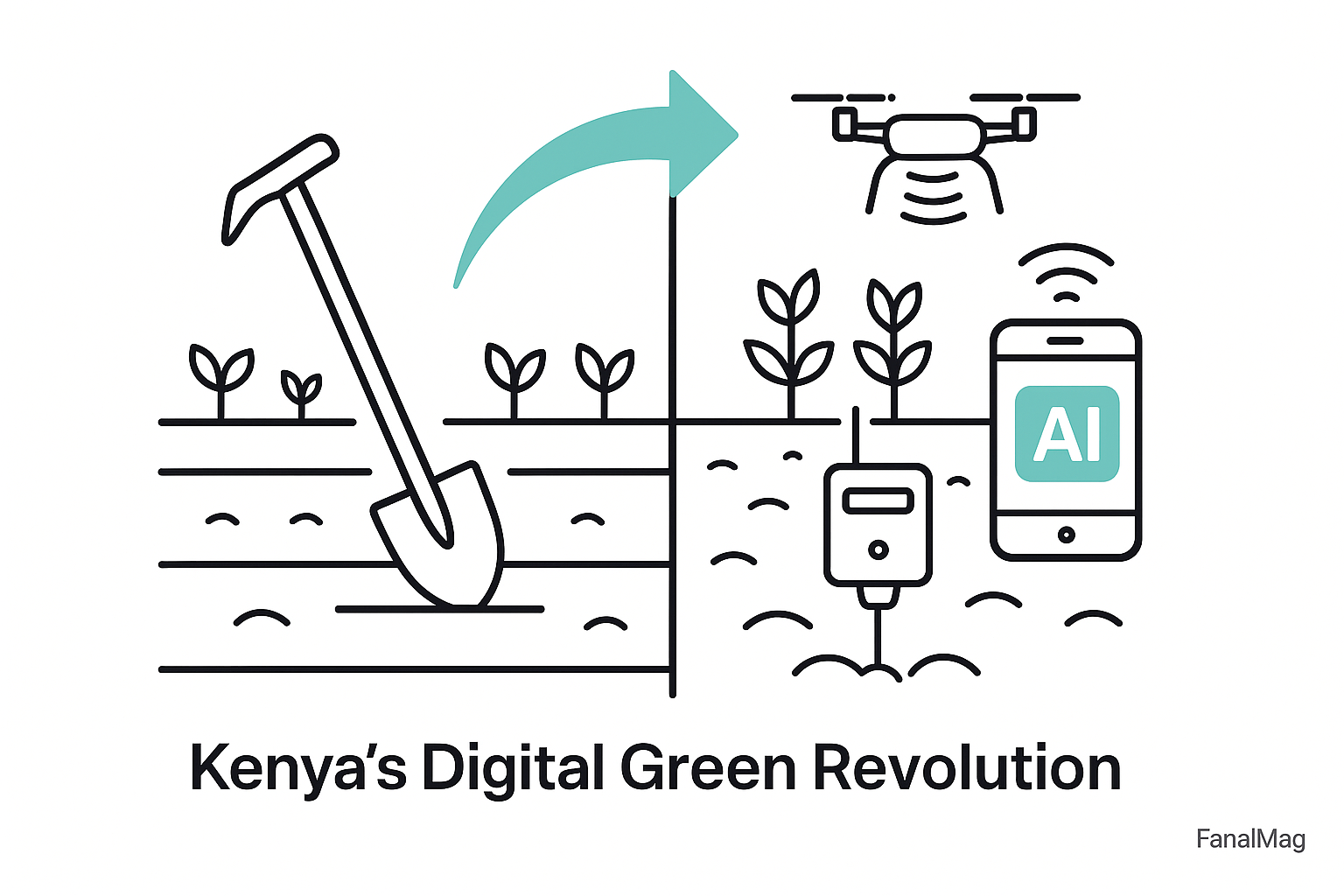
Kenya’s AI farming pilot is no silver bullet. Yet in a continent where the Green Revolution was patchy, this could be the digital equivalent—less about tractors, more about algorithms.
The question isn’t whether AI can recognise a diseased leaf. It’s whether Africa can build the policies, training, and equity to ensure that every farmer benefits.
In the end, the battle for Africa’s food security may be won not by fertilisers or new seeds, but by a farmer holding a phone in one hand, and a hoe in the other—with AI whispering what to do next.

